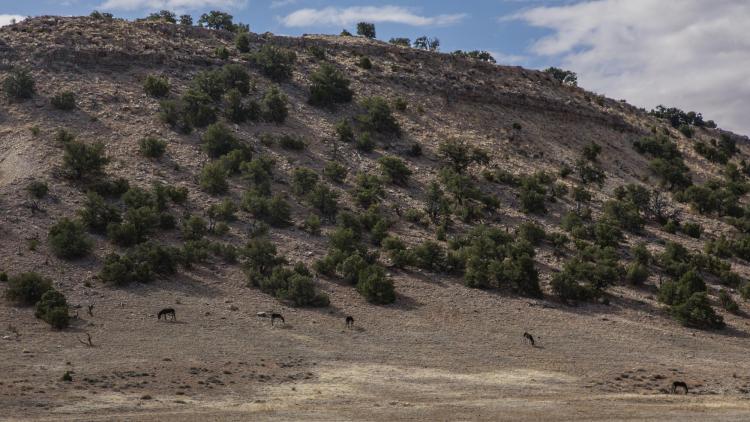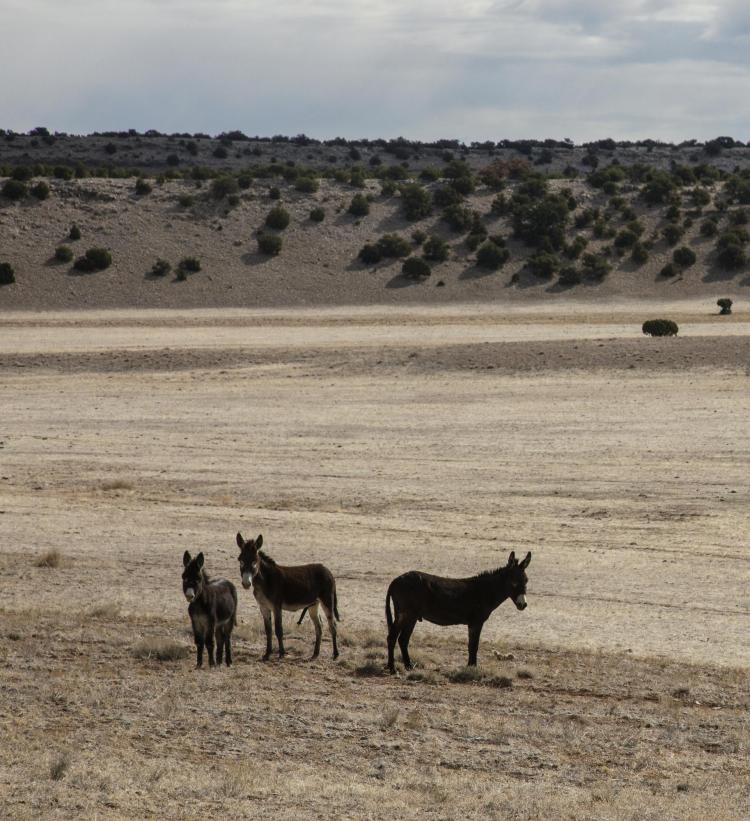Wild burros on the San Rafael Swell
Wild or free roaming burros and horses are protected by Federal Law as "living symbols of the historic and pioneer spirit of the West.”
A few miles south of the historic swinging bridge crossing the San Rafael River, a group of 10 burrows grazed on a rolling plain beneath hills dotted with piñon pines and Utah juniper. They were in two clusters of 5, and as my vehicle rolled slowly to a stop, the cluster nearest the road moved quietly toward the more distant cluster. This group was comprised of adult males and females and a juvenile, and it resides in the Sinbad Herd Management Area (HMA). According to the Bureau of Land Management (BLM), the Sinbad HMA runs from the eastern edge of the San Rafael Swell to Eagle Canyon and has a management size of almost 100,000 acres that should support 50 to 70 burros. In over 20 years of exploring the Colorado Plateau I have not seen burros before, but BLM lists additional herds to the south, along Muddy Creek and in Canyonlands.
The first horses evolved in North America 55 million years ago."
Where did the Sinbad burro herd come from? That question can be answered at several levels, and it is a long story, for burros are not native to North America. It is best to start at the beginning.
The first horses evolved in North America 55 million years ago and they colonized Asia by crossing the Bering Strait at times when glaciers were large and sea levels low. But they were hardly recognizable as horses, for they were about the size of a collie. Horses in North America went extinct shortly after the Clovis people arrived, approximately 13,000 years ago, coincident with the megafaunal extinction which claimed saber-toothed cats, mastodons, camels and giant cave bears. But horses survived in Africa and Asia.

At the top of the page: Two adult males and a juvenile burro in the Sinbad Herd on the San Rafael Swell. Above: A cluster of 5 burros showing the hillside. Photos by Jeff Mitton.
The genus Equus, which includes modern horses, zebras and wild asses, evolved about 5.6 million years ago in Africa. Several species of wild asses became adapted to environments from Northern Africa to the Tibetan Plateau. The African wild ass, Equus africanus, was domesticated about 6,000 years ago in northeastern Africa. Ten burro skeletons were entombed 5,000 years ago with an Egyptian King at Abydos and these well-preserved skeletons exhibit intermediate forms bridging wild African asses and the domesticated lineage, called burros or donkeys.

Two adult males and a juvenile burro in the Sinbad Herd on the San Rafael Swell
The first burros to reach the Americas accompanied Christopher Columbus on his second trip across the Atlantic, landing in Hispaniola in 1495. Burros were taken to Mexico by the first bishop of Mexico in 1528 and the first burros to cross the Rio Grande were probably brought in 1598 by Juan de Oñate, conquistador and first colonial governor of the province of Santa Fe de Nuevo México. From there, burros moved north and west, first with missionaries and later with miners prospecting for gold and silver.
Burros have lived on the San Rafael Swell since the early 1800s, when the Old Spanish Trail connected Santa Fe with Los Angeles. The northernmost route passed through Green River and then over the San Rafael Swell. Early travelers lost burros or they were run off by rustlers and the hardy burros quickly established wild herds on the Swell. The Sinbad Herd was supplemented when local uranium mining collapsed in the late 1940s and miners simply abandoned their burros when they left.
When BLM first censused burros in 1974, they estimated that 15,000 lived in the west, but a more recent census reported that the number had declined to 9,000. The BLM also reports that burro populations double about every 5 years, so some form of management is necessary. In 2016, the Sinbad Herd was censused, and 237 burros were rounded up. From those, only 60 were returned to live wild on the Swell, a number consistent with their management plan. But the management area is 100,000 acres, so why is the number of burros so low?
Lands managed by BLM and the Forest Service are referred to as public lands, and these lands are designated multi-use, meaning that there are multiple, conflicting perspectives on how land and wildlife should be managed. BLM reports that the Sinbad area is a managed area for mustangs and burros but is also available for cattle grazing. Their draft management plan for 2016 shows the numbers of cattle permitted to be grazed is 1,500 for the months of November through February. So, the number of burros was to be reduced to 60 so that 1,500 cows could utilize the public lands.
Personally, as an avid user of public lands, I would eagerly vote to adjust the numbers, increasing the numbers of burros and mustangs and reducing the numbers of cows. I see a clear distinction between cows and burrows in the context of public lands. Cows are owned privately and brought to public lands for personal financial gain. Wild or free roaming burros and horses are protected by Federal Law as "living symbols of the historic and pioneer spirit of the West.”

